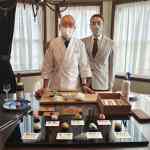
Sawanoi Sake and Ozawa Shuzo Co. Ltd Sake Brewery Tour
- Hiuchi-An: Wagashi Sweets and Tea Ceremony
- Sawanoi Sake and Ozawa Shuzo Co. Ltd Sake Brewery Tour
- Tagikyo Waterfall Meditation and Shukubo Stay with Seizanso, Mitakesan
- Amazing Food Brands in JR East Tokyo Station Gransta
- Stand-Up Paddling in Tokyo: Shiromaru Lake and Odaiba Beach
During my last trip to Japan, I was introduced to the world of sake by Sake Tours which arranged a visit to the famous Ozawa Shuzo Co. Ltd sake brewery in Ome City, Tokyo. This brewery has been producing high-quality sake for over 300 years since it was founded in 1702.
What is sake?
Sake is a traditional Japanese alcoholic beverage made from fermented rice. Its existence in Japan was first mentioned in a 3rd-century record and there was a sake brewing division established in the Imperial Court in the 7th century.

Sake has a special significance in the Shinto religion (Japan’s indigenous faith), where it is considered a sacred beverage used in purification ceremonies and as a symbol of gratitude and respect. In Japanese society, sake represents hospitality, friendship, and celebration and is often served to guests.
This clear alcoholic drink is often served at room temperature or slightly warmed, depending on the type of sake and personal preference. It is usually consumed in ochoko (small cups) and poured from tokkuri (a large bottle).

In recent years, sake has gained popularity worldwide, with many people appreciating its unique taste, cultural significance, and health benefits. Sake is believed to have several health benefits, including improving digestion, reducing the risk of heart disease, and preventing dementia, osteoporosis, and cancer.
How is sake produced?
The production of sake at Ozawa brewery involves several steps, including rice polishing, washing, steaming, and fermentation. The quality of sake depends on the type of rice used, the water source, and the brewing techniques.

- Rice grains are milled to 70% or below (with at least 30% of its original weight removed). For Ozawa’s top-of-the-line sake products, the rice is milled to 35% or below.
- The polished rice is washed and steamed for 40 minutes.
- Fungus is sprinkled over the steamed rice and the mixture is left for 48 hours to become koji.
- Koji is placed in a clean tank with water, steamed rice and purely propagated yeast for two weeks to turn into moto (starter).
- More water, steamed rice and koji are added to moto over four days to make moromi (sake mash).
- Moromi is then kept at a low temperature for 25 to 40 days till it becomes mature, then it is pressed and separated into seishu (pressed sake) and sakekasu (sake lees).
- Seishu is further filtered to fresh sake which is then pasteurised at 65 degrees Celsius and stored in a tank for 6 months.
As 80% of sake is water, Ozawa brewery uses mineral-rich clear spring water from a well that was dug in 1850 just behind the brewery. The brewery is located in Sawai, a place famous for fresh and abundant water, and its sake brand name ‘Sawanoi’ is based on the name of its village.

A little-known fact is that as Ozawa has been a major employer in the region for the past 300 years, it had invested in infrastructure such as housing, roads, and utilities for its employees to live nearby and raise their families comfortably.
Another unique feature of this brewery is its Genroku-gura, a traditional warehouse that has been used for aging sake for over 300 years. It has thick earthen walls and a double roof that prevents light from entering. This keeps the inside temperature stable regardless of the seasons, as temperature fluctuations and light exposure would unfavourably affect sake flavours.

Ozawa brewery brews sake from September to the middle of April. In autumn, it will display a new sakabayashi (a large ball of cedar leaves) with fresh green leaves to replace its old one with brown leaves) at its entrance to indicate that the first sake of the year is ready for sale.

Enjoying sake with Ozawa brewery
Besides going on a guided tour of the Ozawa brewery, visitors can also sample more than 10 different types of sake from ¥200~¥ 500 per cup at its shop on the other side of the road (accessible via an underpass).

The shop, together with its souvenir stalls, Sawainoien (Japanese garden with seats), and tofu restaurants, overlooks the Tama River which is popular for kayaking.

My favourite sake is the Sawanoi daiginjo, which I enjoyed with a tofu lunch at Mamagotoya. This daiginjo had such a clear, serene backnote that blew me away when I first tasted it, and it has set the benchmark for all other daiginjo I will taste in future.
I recommend visiting Ozawa brewery and its surrounding shops, restaurants and museums if you are into history, sake and food pairing, and nature.
Learn about Sawanoi sake and book a tour of Ozawa brewery <ahref=”http: www.sawanoi-sake.com en about#tour” target=”_blank” rel=”noopener”>here</ahref=”http:> (for visitors 20 years and above).
Special thanks to Sake Tours and Ozawa Shuzo Co. Ltd for the tour and sake information.
Sake Tours is a registered tour agency that will take you behind the scenes to meet the people behind the sake, food, and traditional arts and crafts of Japan. All of the team at Sake Tours are Advanced Sake Professionals having studied with the Sake Education Council.










